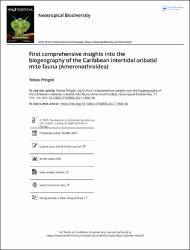First comprehensive insights into the biogeography of the Caribbean intertidal oribatid mite fauna (Ameronothroidea)
| License | This is an Open Access article distributed under the terms of the Creative Commons Attribution License, which permits unrestricted use, distribution, and reproduction in any medium, provided the original work is properly cited. | es |
| Author | Pfingstl, Tobias | |
| Accessioned date | 2024-01-31T02:20:05Z | |
| Available date | 2024-01-31T02:20:05Z | |
| Year | 2021 | |
| Citation | Pfingstl, T. (2021). First comprehensive insights into the biogeography of the Caribbean intertidal oribatid mite fauna (Ameronothroidea). Neotropical Biodiversity, 7(1), 102-110. Recuperado de: | es |
| URI | https://bvearmb.do/handle/123456789/3969 | |
| Abstract | A decade ago the Caribbean was almost completely uncharted in terms of intertidal ameronothroid mites. Now the present data show that these organisms are a common component of the fauna of Caribbean shorelines. Two families of Ameronothroidea are present, the Fortuyniidae with three genera and four species and the Selenoribatidae with five genera and nine species. The most common species are the fortuyniid Alismobates inexpectatus and the selenoribatid Carinozetes mangrovi, both taxa were found in the Northern Caribbean, the Greater and Lesser Antilles as well as on Central American coasts. Six species are endemic to the Caribbean, Litoribates bonairensis, L. floridae, Schusteria marina, Thalassozetes balboa, T. barbara and Thasecazetes falcidactylus. Biogeographic patterns suggest that the genera Carinozetes and Litoribates may have evolved and diversified in the Caribbean region and that the Western Atlantic Bermudian intertidal oribatid mite fauna was largely shaped by Caribbean colonizers. Most of the species found in the Caribbean are typical rock dwellers and only a minority is represented by exclusive mangrove specialists. These species are seriously threatened by the significant progressive decline of mangrove ecosystems throughout the Caribbean. | es |
| Language | English | es |
| Published | Neotropical Biodiversity, 7(1), 102-110 | es |
| Rights | © 2021 The Author(s). Published by Informa UK Limited, trading as Taylor & Francis Group. | es |
| Rights URI | http://creativecommons.org/licenses/by/4.0/ | es |
| Subject | Biodiversidad | es |
| Subject | Fauna | es |
| Subject | Hábitats y especies | es |
| Title | First comprehensive insights into the biogeography of the Caribbean intertidal oribatid mite fauna (Ameronothroidea) | es |
| dc.identifier.doi | https://doi.org/10.1080/23766808.2021.1906136 | |
| Material type | Article | es |
| Type of content | Scientific research | es |
| Access | Open | es |
| Audience | Technicians, professionals and scientists | es |
Files in this item
This item appears in the following Collection(s)
-
Investigación ambiental [1725]
Access and downloading this document are subject to this license: This is an Open Access article distributed under the terms of the Creative Commons Attribution License, which permits unrestricted use, distribution, and reproduction in any medium, provided the original work is properly cited.
© 2021 The Author(s). Published by Informa UK Limited, trading as Taylor & Francis Group.
© 2021 The Author(s). Published by Informa UK Limited, trading as Taylor & Francis Group.


